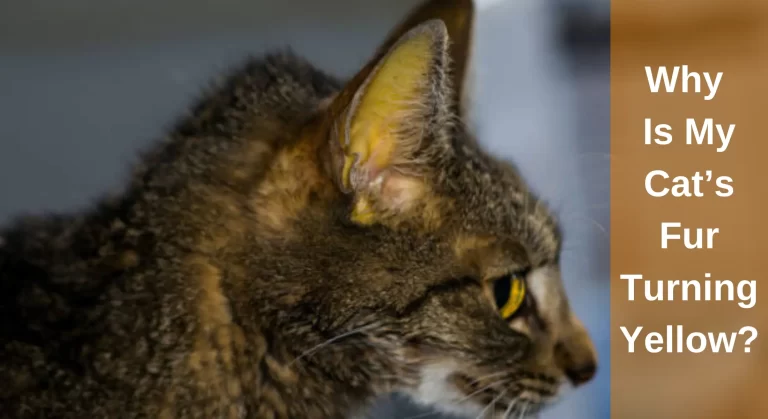How To Get Rid of Skin Tags on Cats? All You Need To Know
Cats commonly develop skin tags, which are tiny, flat, black, or mushy growths that form on the cat’s epidermis. They can get as big as grapes but are often relatively small. Skin tags can develop quickly within a few weeks of discovery, while others may never grow or develop exceptionally slowly. Most skin tags do not contain any liquid. However, they might occasionally resemble tiny pustules.
There are three ways to remove a cat’s skin tag: freezing, cauterizing, and ligation. Freezing cuts off the blood supply to the area, cauterizing burns off the skin tag, and ligation is used to cut off oxygen and blood supply around the skin tag.
Skin tags with cancer need to be treated as soon as possible. Malignant skin tumours are often pink and elevated. They could also be mistaken for skin tags, though.
Here’s a detailed explanation of what causes them and how to get rid of skin tags on cats safely and we’ll also discuss how you can easily remove them from home.

What Does a Cat with Skin Tags Do?
A skin tag can be recognized anywhere on a cat’s body as a lumpy, fleshy skin patch. Typically, blood vessels and collagen are used to create these skin tags. They have skin covering them as well. The skin tags are often small, soft, flesh-coloured lumps with a little elevated look or attached to a stalk.
Skin tages (acrochordon) are risk-free since they don’t contain any malignant cells. Cats often only have one, and they seldom signify illness or disease. Skin tags may be pretty uncomfortable. Skin tags may itch if they are found in regions subject to friction. If they are trapped or grabbed, skin tags can also bleed. Healing from this takes time.
Skin tags can change in size over time; some increase and others decrease. Many are non-cancerous benign growths. Skin tag growth could be influenced by friction.
What Causes Skin Tags on Cats?
In cats, skin tags generally small appear under the collar, or in other parts of the body where the skin is thin. A skin tag may develop due to friction, excess hormones, sweat, old age, insulin resistance, diabetes, or genetics. Generally, they are harmless and non-painful, but when they get snagged on something, they may bleed. Skin tags can become infected if bacteria penetrate the wound.
Skin tags can develop on a cat for several reasons, including:

- Diabetes: According to some research, insulin resistance makes skin tags more likely to appear in diabetic cats. There is no clear explanation for why cats get skin tags, despite all these plausible explanations. You will know if you take your cat to the vet to be examined. It may be one of these things or a mix of a few.
- Genetics: It’s considered that some cat breeds are more prone to getting skin tags.
- Hormones: A cat’s body can be affected by an imbalance of hormones, whether too much or too little, and lead to the development of skin tags.
- Friction: Skin tags are frequently seen between skin folds, such as the armpits, leg joints, chest, and belly. This is because skin tags can develop as a result of friction.
- Old Age: As a cat age, its skin grows looser, which can cause increased friction and skin tags.
- Obesity: It is common for cats with excess skin and obesity to sweat more than those with normal weight or if they have lost a lot of weight.
Are Cat Skin Tags Harmful?
Skin tags are usually not harmful. If benign skin tags do not bother the cat, they can be left alone. In certain situations, skin tags can bleed and get infected. They can also itch or hurt. You need to get treated if a skin tag becomes infected. The doctor could think about removing the skin tags if they are in a place where they are most likely to become infected or if they could interfere with the cat’s ability to perform particular tasks.
Skin tags on the face may cause issues. Your feline buddy’s vision may get impacted if they are found near their eyes. Skin tags around a cat’s mouth can itch and make it challenging for them to eat. A veterinarian should thoroughly inspect these skin tags.
Ways to Get Rid of a Skin Tag on a Cat? Skin Tag Treatment
If a skin tag isn’t disturbing or hurting a cat, most veterinary practitioners will suggest letting it alone. Because of its position, a cat probably won’t even be aware that it’s there unless it gets stuck on anything. Veterinarians use a variety of techniques to remove skin tags, including:

1. Cauterizing
Cauterising uses heat to eliminate the skin tag. The skin tag is burned off while the surrounding skin is sealed to reduce bleeding or infection. But cauterization is a more painful removal technique, and it can be challenging to use in difficult-to-reach places.
2. Cutting
Under local anaesthesia, a veterinarian can remove skin tags. Sterile scissors are used to remove these tags. This removal technique is effective, but the site must be treated daily to avoid infection.
3. Freezing
Freezing, sometimes called cryosurgery, is immediately administering liquid nitrogen to the skin tag. When the region is frozen, the blood supply is cut off, killing the skin tag and causing it to come off. Don’t be frightened if the skin’s colour changes briefly after the treatment. This is typical and shows that the therapy is effective.
4. Ligation
A veterinarian will securely tie a sterile length of thread around the base of the skin tag during ligation to deprive it of oxygen and cut off its blood supply. This tag will get dark with time and then fall off the skin.
Does My Cat Have A Skin Tag? Is It Really a Skin Tag?
Understanding the various cat skin growths can help you determine what they are and whether or not you should be concerned. The many skin growths that you could notice on a cat include the following:

1. Skin Tumours
It is difficult to identify skin tumors because they usually appear as small lumps or bumps. The first time you feel an unidentified lump, it may seem alarming, but they are not all cancerous.
There is a potential that a growth on your cat’s skin that becomes larger or changes shape is malignant or cancerous. In this situation, you should visit the veterinarian right away to have testing done to see if the development is a skin tumour.
2. Warts
Depending on their appearance, warts can be dark, light, or skin-colored, and some may even disappear on their own. The symptoms are usually itchy skin, such as scratching, which causes cats to continue irritating the area. In the case of itchy skin, you can soothe it at home, but you should see a vet if the wart is causing the itching
Cats seldom develop warts, although they are conceivable. Papillomas, the name for these viral warts, are often flat and scaly. Although they can pass from cat to cat, they usually disappear with time.
It is relatively rare to see them on cats, usually on the corners of their eyes, their mouths, and their noses. Cats that are older are more likely to develop warts.
3. Ticks
A growth on your cat’s skin that you initially believed to be a skin tag may be a tick if you look attentively. You can easily spot ticks on a cat’s head, neck, ears, and feet.
Ticks can burrow so deeply into your cat’s skin that they resemble a skin growth. A veterinarian can safely remove this from your cat.
If you are unsure whether your cat has a skin tag or tick, take a closer look at its appearance. Ticks are swollen and engorged, whereas skin tags are flat.
3. Abscess
A cat will often develop an abscess on its skin where they have been bitten or scratched. It is a pus-filled, swollen growth. Cats often experience discomfort from abscesses. Therefore a veterinarian may advise using an antibiotic or anti-inflammatory medication to treat the abscess and lessen the pain.
5. Acne
Just like us, cats may develop acne. Blackheads may appear as little pimples on your cat’s chin or face. Your veterinarian can suggest a thorough wash or medication if your cat has acne to treat it.
6. Bug Bites
Mozzies, bees, and wasp stings can also result in odd lumps on your cat’s skin.
Can You Remove a Skin Tag From a Cat at Home?
Visiting the vet for your cat may be stressful and expensive. You might get rid of your cat’s skin tag on your own using the ligation technique if it is big enough for you to grasp. To prevent your cat from suffering harm, you must establish a high degree of trust with it before you do. You may remove a skin tag by yourself by doing the following:

- Apply an antiseptic solution to the skin tag and the surrounding region to clean it. To reduce the risk of illness, wash your hands with antiseptic soap.
- Wrap a tie, such as dental floss or a little string length, snugly around the skin tag’s base. If there is a lot of fur covering the skin tag, gently shave the region to make it easier to access the skin tag.
- Trim the tie’s ends to prevent them from fraying or catching on to anything. Your cat may make a fuss after you knot the skin tags, but you should resist the impulse to untie them since your cat will eventually stop seeing them.
- If you can reach the skin tag safely and there is no danger to your cat, you should only try to remove the label.
How To Prevent Skin Tags on Cats?
Skin tags seldom need to be worried about, but if they develop in peaceful places, they could. You should avoid creating skin tags because of this. There are some things you can do that can be helpful:
- Use feline shampoos that may aid in removing accumulated perspiration.
- Keep up a nutritious, protein– and vitamin-rich diet. Skin tags may result from insulin resistance, which is connected to diabetes.
- The problem will be worse by a bad diet. If a cat’s skin folds begin to rub against one another, it can also result in obesity, another major factor in developing skin tags.
- Ensure the collar is tight enough and tight enough if your cat wears one. As a cat develops, adjust the collar to ensure a snug fit.
How Do I Know Skin Tag on My Cat Infected?
Skin tags may occasionally get infected. The likelihood of the skin tag becoming stuck on anything is higher in cats who like scaling fences and roaming free in the open.
Bacteria may enter the wound and cause an infection if this occurs when the skin tag sustains a cut or tear. If you ignore this, it will hurt and only become worse.

Blackened Skin Tag on Cat
Skin tags can develop an infection and turn black. Successful blood restriction has caused the skin tag to thrombose. The skin tag will probably completely disappear if you wait a few more days. It requires nothing from you other than ensuring that it stays tidy.
How to Handle a Bleeding Skin Tag on a Cat?
Skin tags are readily punctured and will bleed if they are. Like a typical wound, the skin will tear and bleed. The skin tag will go, albeit it can get infected. Sterilization will have to be done often.
If a skin tag gets trapped, it could be beneficial because it’s more likely to die and fall off. Grab a clean piece of cloth and apply pressure to help the blood clot to stop the bleeding. Use a tiny bandage to prevent bacteria from penetrating the incision and causing infection.
Despite your best efforts to prevent them, some cats are prone to developing skin tags. However, these skin tags are not harmful. You should only think about skin tag removal if your cat begins to exhibit indications of discomfort.
Frequently Asked Questions
Where does Skin Tag appear on cats?
The neck and the top portion of the legs close to the tummy are familiar places for skin tags to develop on cats. They are found on the feline’s ears, lips and eyelids.
Are Cat Skin Tags Common?
Skin tags in cats are natural. Skin tags are harmless to your cat and usually do not suggest any illness or disease because they do not contain malignant cells. Cats frequently don’t even realize they have skin tags till one of them bleeds or becomes entangled in something.
A cat skin tag may be dangerous only if it’s near the animal’s eyes or mouth. They may find it challenging to see or eat, reducing their quality of life. In this situation, you should take your cat to the doctor to determine whether the skin tag can be removed.
Does skin tag go away itself?
The body can shed skin tags spontaneously if a lack of blood causes the skin to twist and die.
What does a skin tag on a cat look like?
In most cases, skin tags are soft, flesh-colored bumps that dangle from a stalk or have a slight raised surface. Tags can be small at the start and gradually grow larger over time, or they can stay the same size.
Wrap Up!
The majority of the time, a lump on your cat’s skin will be nothing more than a simple skin tag. Nevertheless, finding an odd bulge on your cat is undoubtedly unsettling. While a cat skin tag may appear frightening, it is mostly simply a benign collection of cells that is painless and safe for your cat. But it’s always a good idea to take your cat to the doctor to check the skin tag if you’re ever worried about it.
Related Posts:
Who is Isabella?
My name is Isabella, and I am a dedicated and knowledgeable cat enthusiast. With years of experience caring for cats and a deep love for felines, I made a mission to help other cat lovers navigate the challenges of cat ownership.






